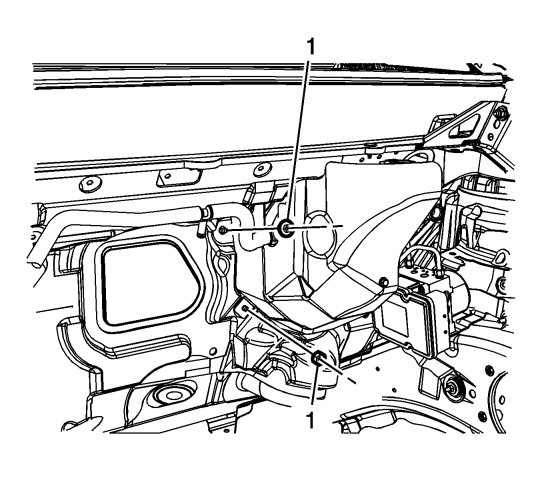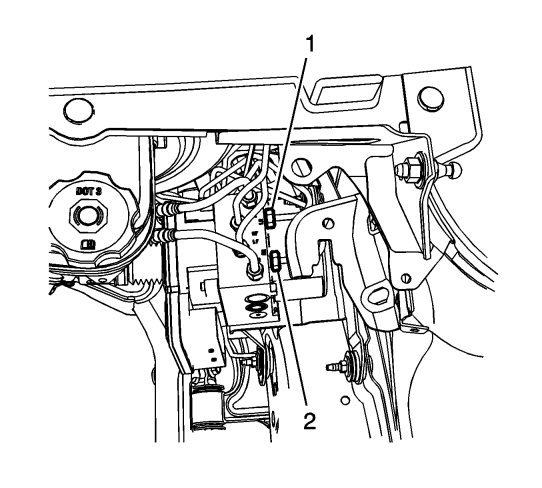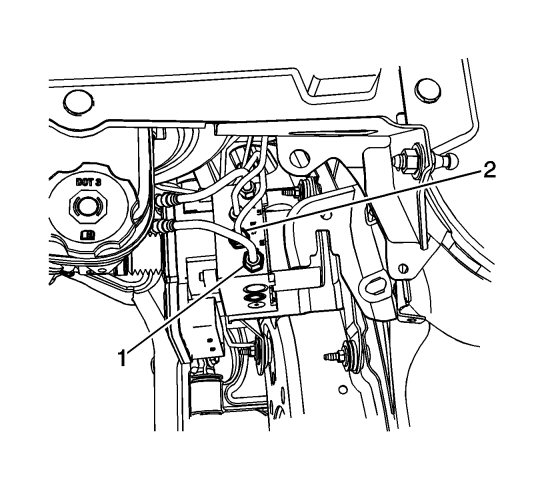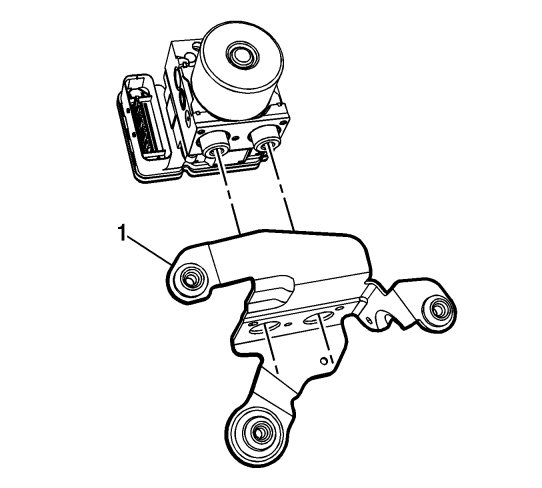Brake Pressure Modulator Valve Replacement
| Brake Pressure Modulator Valve Replacement |
| Removal Procedure |
Refer to Brake Fluid Irritant Warning .
Refer to Brake Fluid Effects on Paint and Electrical Components Caution .
|
|||||||
| 1. |
Turn the ignition switch to the OFF position.
|
|
| 2. |
Without draining the coolant or removing the hoses, remove and position aside the radiator surge tank. Refer to
Radiator Surge Tank Replacement (LAU)
Radiator Surge Tank Replacement (LF1)
.
|
|
| 3. |
If equipped with the master cylinder heat shield, remove the master cylinder heat shield nuts (1). 
|
|||||||
| 4. |
Remove the master cylinder heat shield bolt (1).

|
|
| 5. |
Remove the master cylinder heat shield.
|
|
| 6. |
Disconnect the electronic brake control module (EBCM) electrical connector.

|
|
| 7. |
Disconnect the left rear brake pipe fitting (1) at the brake pressure modulator valve (BPMV).
|
|
| 8. |
Cap the brake pipe fitting and plug the BPMV outlet port to prevent brake fluid loss and contamination.
|
|
| 9. |
Disconnect the right rear brake pipe fitting (2) from the BPMV.
|
|
| 10. |
Cap the brake pipe fitting and plug the BPMV outlet port to prevent brake fluid loss and contamination.
|
|
| 11. |
Disconnect the master cylinder secondary brake pipe fitting (1) from the BPMV.

|
|
| 12. |
Cap the brake pipe fitting and plug the BPMV inlet port to prevent brake fluid loss and contamination.
|
|
| 13. |
Disconnect the left front brake pipe fitting (2) from the BPMV.
|
|
| 14. |
Cap the brake pipe fitting and plug the BPMV inlet port to prevent brake fluid loss and contamination.
|
|
| 15. |
Disconnect the right front brake pipe fitting (1) from the BPMV.

|
|
| 16. |
Cap the brake pipe fitting and plug the BPMV outlet port to prevent brake fluid loss and contamination.
|
|
| 17. |
Disconnect the master cylinder primary brake pipe fitting (2) from the BPMV.
|
|
| 18. |
Cap the brake pipe fitting and plug the BPMV inlet port to prevent brake fluid loss and contamination.
|
|
| 19. |
Remove the BPMV bracket nuts (1).

|
|
| 20. |
Remove the BPMV and bracket assembly.
|
|
| 21. |
If necessary, remove the BPMV bracket bolts (1).

|
|
| 22. |
Remove the BPMV bracket (1).

|
|
| 23. |
Inspect the insulators for damage and replace, if necessary.
|
|
| 24. |
If necessary, remove the EBCM. Refer to
Electronic Brake Control Module Replacement
.
|
|
| Installation Procedure |
| 1. |
Replace the EBCM if it has been removed. Refer to
Electronic Brake Control Module Replacement
.
|
|
| 2. |
Install the BPMV bracket (1), if necessary.

|
|
| 3. |
Refer to
Fastener Caution
.
If removed, install the BPMV bracket bolts (1) and tighten to 12 Nm (106 lb in) . 
|
|
| 4. |
Install the BPMV and bracket assembly.

|
|
| 5. |
Install the BPMV and bracket assembly nuts (1) and tighten to
10 Nm (89 lb in)
,
|
|
| 6. |
Connect the right front brake pipe fitting (1) to the BPMV and tighten to
19 Nm (14 lb ft)
.

|
|
| 7. |
Connect the master cylinder primary brake pipe fitting (2) to the BPMV and tighten to
19 Nm (14 lb ft)
.
|
|
| 8. |
Connect the master cylinder secondary brake pipe fitting (1) to the BPMV and tighten to
19 Nm (14 lb ft)
.

|
|
| 9. |
Connect the left front brake pipe fitting (2) to the BPMV and tighten to
19 Nm (14 lb ft)
.
|
|
| 10. |
Connect the left rear brake pipe fitting (1) to the BPMV and tighten to
19 Nm (14 lb ft)
.

|
|
| 11. |
Connect the right rear brake pipe fitting (2) to the BPMV and tighten to
19 Nm (14 lb ft)
.
|
|
| 12. |
Connect the EBCM electrical connector.
|
|
| 13. |
Install the master cylinder heat shield, if equipped.

|
|
| 14. |
Install the master cylinder heat shield bolt (1) and tighten to
10 Nm (89 lb in)
.
|
|
| 15. |
Install the master cylinder heat shield nuts (1) and tighten to 25 Nm (18 lb ft) . 
|
|||||||
| 16. |
Install the radiator surge tank. Refer to
Radiator Surge Tank Replacement (LAU)
Radiator Surge Tank Replacement (LF1)
.
|
|
| 17. |
Bleed the hydraulic brake system. Refer to
Hydraulic Brake System Bleeding (Manual)
Hydraulic Brake System Bleeding (Pressure)
.
|
|
| 18. |
Turn the ignition switch to the ON position.
|
|
| 19. |
Perform the
Diagnostic System Check - Vehicle
.
|
|
| 20. |
Observe the brake pedal feel after performing the diagnostic system check. If the pedal now feels spongy, air may have been in, or may have been introduced into the primary circuit.
|
|
| 21. |
If the pedal feels spongy, perform the
Antilock Brake System Automated Bleed
.
|
|

 Warning
Warning

